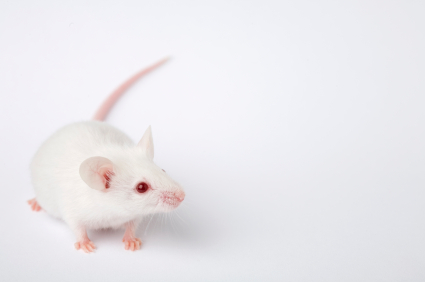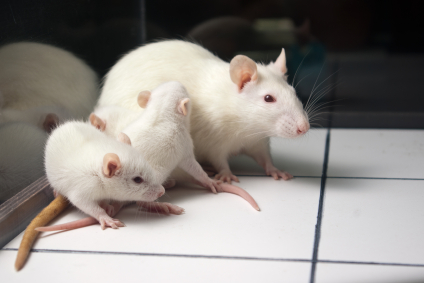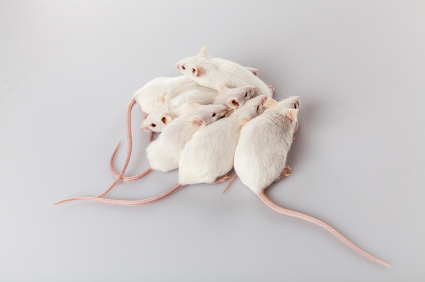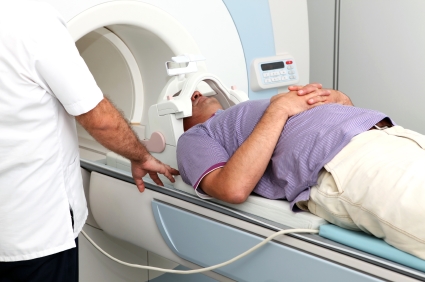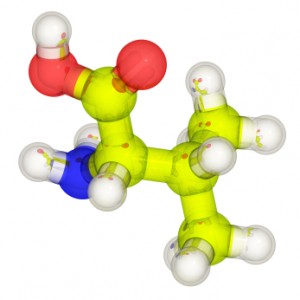Depression May Not Be All in Your Head
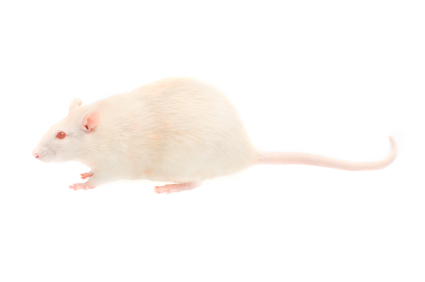 Repeated social defeat stress (when an intruder mouse is repeatedly threatened by a larger mouse defending its home territory) is often used as a model to study human depression. Animals repeatedly exposed to social defeat stress start to exhibit depression-like behaviors such as social avoidance and loss of interest in sucrose. Georgia Hodes, a researcher at Mount Sinai School of Medicine, reported at a recent scientific meeting that repeated defeat stress–induced behavior was blocked when IL-6, an inflammatory cytokine released by white blood cells in the blood, was inhibited. The central nervous system did not appear to be involved.
Repeated social defeat stress (when an intruder mouse is repeatedly threatened by a larger mouse defending its home territory) is often used as a model to study human depression. Animals repeatedly exposed to social defeat stress start to exhibit depression-like behaviors such as social avoidance and loss of interest in sucrose. Georgia Hodes, a researcher at Mount Sinai School of Medicine, reported at a recent scientific meeting that repeated defeat stress–induced behavior was blocked when IL-6, an inflammatory cytokine released by white blood cells in the blood, was inhibited. The central nervous system did not appear to be involved.
Interestingly, mice with more white blood cells and more IL-6 release at baseline (prior to the social defeat stress) were more likely to show the defeat-stress depressive behaviors.
Editor’s Note: The higher number and greater reactivity of white blood cells seen in these mice could be a clinical marker of vulnerability to defeat stress, and such findings are worthy of study in human depression. White blood cells are critical to fighting infection and sometimes their overactivity can contribute to inflammation. In meta-analyses, a subgroup of depressed patients consistently show elevated inflammatory markers (including IL-1, IL-6, TNF alpha, and CRP), and it remains to be seen whether these markers of inflammation are generated in the central nervous system or come from white blood cells in the blood, and whether their targeted suppression could be a new route to antidepressant effects (as in the study of defeat stress in mice).
Information from Environmental Experiences Can Be Passed on in Dad’s Sperm
Contrary to all common sense, researcher Brian Dias showed that when rats that were future fathers learned to associate an odor with a shock, this learning could be passed on to the next generation when the father mated with a female rat that had not learned the same association.
It turns out that the next generation of rat pups shows increased behavioral reactivity to the odor in a process different from the fear conditioning they might exhibit if they learned to avoid the odor through their own experiences.
Presumably, the pup is somehow programmed through an epigenetic modification of the father’s sperm to grow more neurons from the nose to the olfactory bulb that specifically react to the odor its father feared, and not to other odors. Miraculously, when the second generation pup grows up and fathers a third generation pup, the new pup also shows increased behavioral sensitivity to that specific odor. How the odor information from the first generation is represented in the fathers’ sperm and passed on to their descendants is still a complete mystery.
There are also new data that a father rat fed a diet deficient in folic acid (vitamin B9) will sire offspring with more congenital malformations. Additionally, an obese father rat fed a diet that includes extra fat calories will sire pups that become obese as adults even when fed a normal milk diet from a svelte mother before weaning and then fed a normal diet after weaning.
Mothers’ behavior usually gets most of the credit and/or blame for her children’s behavior, but now it looks like fathers’ diet or behavior (even before they have children) may have lasting consequences for their offspring.
Conditioned Fear Can Be Transmitted Transgenerationally in Rodents
Scientists often use fear conditioning to study rodents’ learning and behavior. If a particular stimulus (such as a light, a sound, or an odor) is presented paired with the delivery of a mild shock, the animal begins to associate the stimulus with the shock and will freeze when it is presented and avoid the stimulus.
New research shows that if a pregnant rat (known as a dam) goes through fear conditioning that pairs an odor with a shock, the rat’s offspring will also avoid that odor into adolescence. Even if the pups are raised by a different mother who never went through the fear conditioning, they still avoid the odor into adolescence, showing that they do not learn the behavior through watching their mother.
The conditioning is specific to the particular odor, such that a different odor not used in the fear conditioning does not evoke a heightened reaction from the pups. It appears that the pup learns the fear through chemical signals, such as alarm pheromones that can pass through the placenta.
Rats Learn Fear Conditioning From One Another
Rats who are taught to associate a light with an electric shock learn to avoid the light. This process is known as conditioned fear. New research shows that if one rat watches another rat go through fear conditioning, the observing rat will also show the effects of fear conditioning. It will also avoid the light, but only if it had previous experience with fear conditioning. It appears that rats have the ability to learn from other rats’ painful experiences.
Learning to Change Brain Activity to Decrease Cocaine Craving
Colleen Hanlon, a researcher at the Medical University of South Carolina, has found that biofeedback can be used to decrease cocaine craving in people with substance abuse problems. In her research, patients were given real time feedback from functional magnetic resonance imaging (fMRI) and learned to decrease the activation of a part of the brain called the anterior cingulate when exposed to cocaine cues (reminders of their desire for cocaine). They were able to decrease drug craving as well as heart rate and skin conduction, which often accompany it.
A Common Variant of BDNF Predicts Non-Response to IV Ketamine
Brain-derived neurotrophic factor (BDNF) is a protein in the brain that protects neurons and is necessary for long-term memory and learning. Different people have different genetic variations in BDNF depending on which amino acid the gene that codes for it inserts into the protein, valine or methionine. There are three possible combinations that vary in their efficiency. The Val66Val allele of BDNF is the most efficient for secreting and transporting BDNF within the cell body to synapses on dendrites, and is also a risk factor for early onset of bipolar disorder and rapid cycling. Twenty-five percent of the population has a Met variant (either Val66Met or Met66Met), which functions less efficiently. These people have mild decrements in some cognitive processing.
Increases in BDNF are necessary to the antidepressant effects of intravenous ketamine. In animals, ketamine also rapidly changes returns dendritic spines that had atrophied back to their healthy mushroom shape in association with its antidepressant effects. According to research published by Gonzalo Laje and colleagues in the journal Biological Psychiatry in 2012, depressed patients with the better functioning Val66Val allele of BDNF respond best to ketamine, while those with the intermediate functioning Val66Met allele respond less well.
Researcher Ronald S. Duman of Yale University recently found that increases in BDNF in the medial prefrontal cortex are necessary to the antidepressant effects of ketamine. If antibodies to BDNF (which block its effects) are administered to the prefrontal cortex, antidepressant response to ketamine is not observed.
Duman also found that calcium influx through voltage sensitive L-type calcium channels is necessary for ketamine’s antidepressant effects. A genetic variation in CACNA1C, a gene that codes for a subunit of the dihydropiridine L-type calcium channel, is a well-replicated risk factor for bipolar disorder. One might predict that those patients with the CACNA1C risk allele, which allows more calcium influx into cells, would respond well to ketamine.
Longitudinal Trajectory of Childhood Bipolar Disorder
Most children recover from an episode of bipolar disorder after a considerable period of time, but the majority eventually relapse. At the 2013 meeting of the American Academy of Child and Adolescent Psychiatry (AACAP), Boris Birmaher of the University of Pittsburgh presented new data on the long-term prospective course of bipolar disorder in 255 children with bipolar I, 30 children with bipolar II, and 153 children with bipolar NOS (not otherwise specified), who together had an average age of onset of 9.3 +/- 3.9 years. The children participated in the study for an average of 8 years. Most of the children (81.5%) recovered from their episode, but only after an average of 2.5 years of follow up treatment. Yet 62.5% of those who recovered experience a recurrence after an average of 1.5 years.
Editor’s Note: It takes a long, long time to achieve recovery, and longer for bipolar NOS (more than 2 years on average) than for either Bipolar I or II (about 1.8 years). However, the high rate of relapse within 1 to 2 years is equally disturbing. These data are similar to those in many other prospective follow up studies of children, and suggest that it is important for parents to be aware that this illness is difficult to treat, and good results within weeks are not likely to be the norm. At the same time, 43% of the children with a bipolar diagnosis eventually achieved euthymia (wellness) in the longer term, so there is cause for some optimism.
Four Trajectories in Children with Bipolar Illness
Birmaher described four different long-term,trajectories observed over an average of 8 years of follow up with 438 children with bipolar disorder.
- Predominately euthymic (24%)
- Ill early then much improved (19%)
- Mild to moderately ill—euthymic only 47% of the time (34.6%)
- Predominantly ill—euthymic 11.5% of the time (20.3%)
Explaining Wellness
The predominantly well group (1) was associated in a univariate analysis with a later onset of illness, higher socio-economic status, less conflict, fewer stressors, less sexual abuse, fewer anxiety and ADHD comorbidities, and less medication (including stimulant use). In a multivariate analysis, this group was independently associated with less severe depression/mania, less suicidal ideation, less substance use, less sexual abuse, and less family history of mania and substance abuse.
This group had the best functioning, almost to 80 on the Children’s Global Assessment Scale (C-GAS). In comparison, despite considerable time euthymic for groups 2 and 3, these children still had considerable functional impairment, in the realm of 65 on the C-GAS scale. Even in Group 1, about half of the children had low C-GAS scores.
Birmaher suggested the importance of trying to find ways to delay the onset of the illness (to graduate more children into the good prognosis group) and allowing them time to develop socially and educationally and graduate from high school. Potential preventive strategies could include omega-3 fatty acids, more time spent exercising, good sleep hygiene, family focused therapy (FFT), dialectic behavior therapy, treating subsyndromal depression, and even treating parents with mood disorders to complete remission (which has been shown to improve behavioral health in offspring).
Editor’s Note: As this editor Post, Chang, and Frye wrote in the Journal of Clinical Psychiatry in 2013, beginning to study the effectiveness of these kinds of early primary and secondary prevention strategies in children who can now be readily identified clinically as at risk for a mood disorder, should be given the highest priority.
Children who have at least one parent with a bipolar or unipolar disorder, some further environmental risk factors (such as adversity in early childhood), and early symptoms of depression, anxiety, or prodromal bipolar disorder are at very high risk for bipolar disorder, and there is an urgent need for randomized studies (even open ones) of safe potential preventive strategies for these children.
Omega-3 fatty acids in particular have a strong record of safety, compelling rationale for use in bipolar disorder, and have already been shown to have significant preventive effects in decreasing the transition from early prodromal psychosis to full-blown schizophrenia.
Inflammatory Markers of Bipolar Illness Course
 People with bipolar disorder often show signs of inflammation. These could eventually help clarify diagnosis, illness activity, and treatment response, and predict illness progression. Previous studies have shown increases in c-reactive protein (CRP), interleukin-6 (IL-6), and tumor necrosis factor-alpha (TNF-alpha) in adults with mood disorder. These high levels tend to improve with medications, are related to illness severity, and are also related to manic and mixed states.
People with bipolar disorder often show signs of inflammation. These could eventually help clarify diagnosis, illness activity, and treatment response, and predict illness progression. Previous studies have shown increases in c-reactive protein (CRP), interleukin-6 (IL-6), and tumor necrosis factor-alpha (TNF-alpha) in adults with mood disorder. These high levels tend to improve with medications, are related to illness severity, and are also related to manic and mixed states.
At the 2013 meeting of the American Academy of Child and Adolescent Psychiatry (AACAP), Ben Goldstein reported on a study that examined levels of TNF alpha, IL-6, and high sensitivity CRP (hsCRP) in 123 adolescents with an average age of 20.4 years, who had been ill for an average of 12.7 years.
CRP levels in adolescents with bipolar illness were equivalent to those with rheumatoid arthritis, and much higher than healthy controls. In children with bipolar disorder, higher levels of CRP were related to more time symptomatic. High hsCRP was related to lower socio-economic status and to substance abuse disorders.
Increases in IL-6 were linked to a longer time to achieve remission and more weeks depressed. High IL-6 was related to duration of illness, positive family history of substance use, and family conflict.
High TNF alpha was related to low socioeconomic status (SES), self-injury, suicidal ideation, and positive life events.
Goldstein said studies of these markers could eventually lead to therapeutic advances, but the process would be long and would require several steps: proof of concept studies, prospective validation studies in independent samples, and demonstration of clinical gains over standard predictive markers, culminating in enhanced patient care and outcome through better, faster prediction of response.
Editor’s Note: Ideally clinicians could jump ahead by immediately attempting to determine whether adding a medication with direct anti-inflammatory effects could enhance therapeutic effects in children with elevated inflammatory markers. Treating inflammation could also theoretically help prevent cognitive deterioration and decrease the considerable risk for cardiovascular dysfunction in patients with bipolar disorder.
Worsening Comorbidities Relate To Adverse Bipolar Outcomes
 Many children with bipolar disorder also present with other comorbid Axis I psychiatric illnesses. Now it seems that the worsening of these comorbidities, such as attention-deficit hyperactivity disorder (ADHD) or an anxiety disorder, can signal a more difficult course of bipolar illness itself. At a symposium on the course of bipolar disorder in children at the 2013 meeting of the American Academy of Child and Adolescent Psychiatry (AACAP), Shirley Yen from Brown University discussed findings on comorbidities of childhood onset bipolar disorder from COBY, the Collaborative Child Bipolar Network. Upon study entry, 60% of children with bipolar disorder also had ADHD, 40% had oppositional defiant disorder (ODD), 39% had an anxiety disorder, 12.5% had both oppositional defiant disorder and a conduct disorder, and 9% had a substance abuse disorder.
Many children with bipolar disorder also present with other comorbid Axis I psychiatric illnesses. Now it seems that the worsening of these comorbidities, such as attention-deficit hyperactivity disorder (ADHD) or an anxiety disorder, can signal a more difficult course of bipolar illness itself. At a symposium on the course of bipolar disorder in children at the 2013 meeting of the American Academy of Child and Adolescent Psychiatry (AACAP), Shirley Yen from Brown University discussed findings on comorbidities of childhood onset bipolar disorder from COBY, the Collaborative Child Bipolar Network. Upon study entry, 60% of children with bipolar disorder also had ADHD, 40% had oppositional defiant disorder (ODD), 39% had an anxiety disorder, 12.5% had both oppositional defiant disorder and a conduct disorder, and 9% had a substance abuse disorder.
The prevalence of most of these comorbid illnesses increased over time (e.g. anxiety disorder rates increased from 39% to 62%). The illnesses were also related to the time it took participants to achieve recovery (eight consecutive weeks well), and the time until a recurrence of a depressive or manic episode.
Increases in anxiety were linked to longer time to achieve recovery and a shorter time to a recurrence. Increases in ADHD were linked to a more rapid onset of a depressive recurrence. Increases in oppositional defiant disorder and conduct disorder had no relationship with either remission or recurrence. Increases in substance abuse disorders were linked to a longer time to recover from a manic episode. Thus, worsening of the comorbid conditions had definite consequences for both recovery and recurrence.
Irritable, Elated, And Combined Bipolar Subtypes in Children Are Similar
Research on early-onset bipolar disorder has often hinged on identifying the key characteristics of the disorder. At a symposium on the course of bipolar disorder in children at the 2013 meeting of the American Academy of Child and Adolescent Psychiatry (AACAP), Jeff Hunt of Brown University discussed findings from COBY, the Collaborative Child Bipolar Network. He described the course of illness in 446 children with bipolar disorder, including 10% who had irritability at baseline, 15% who had elated mood at baseline, and a majority (75%) who had both irritability and elation at baseline.
Most factors such as positive family history of bipolar illness and comorbidities including attention deficit hyperactivity disorder (ADHD) did not differ across the three groups. The three subtypes (irritable, elated, or mixed) did not remain stable, and most of the children eventually converted to the combined irritable and elated subtype. These data contrast with those of Ellen Liebenluft et al., who found that those with severe mood dysregulation or chronic irritability (but not other key characteristics of bipolar disorder) did not go on go on to receive a bipolar diagnosis and tended not to have a family history of bipolar disorder.

